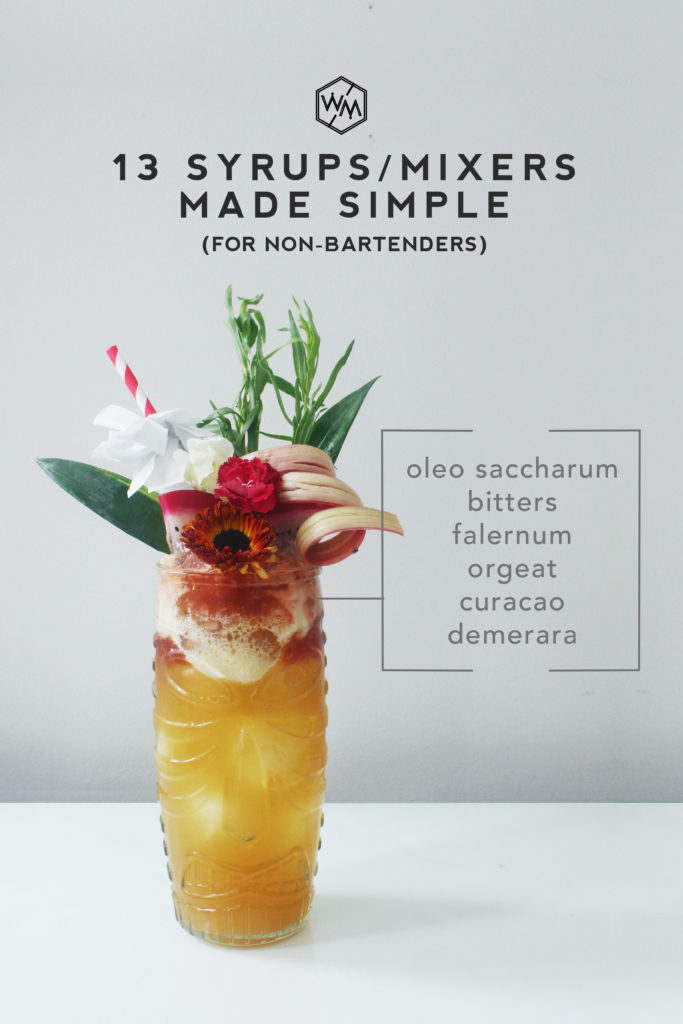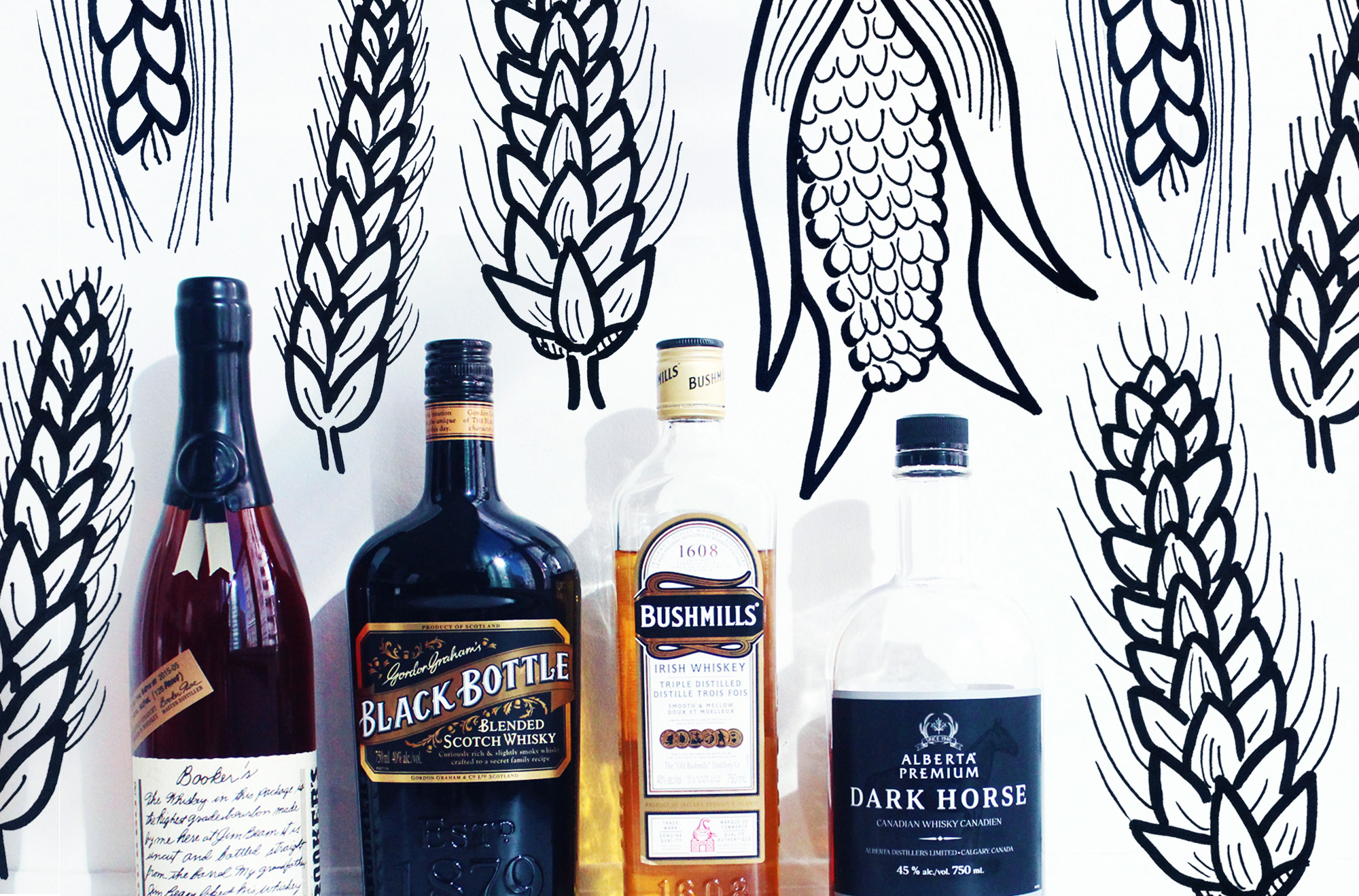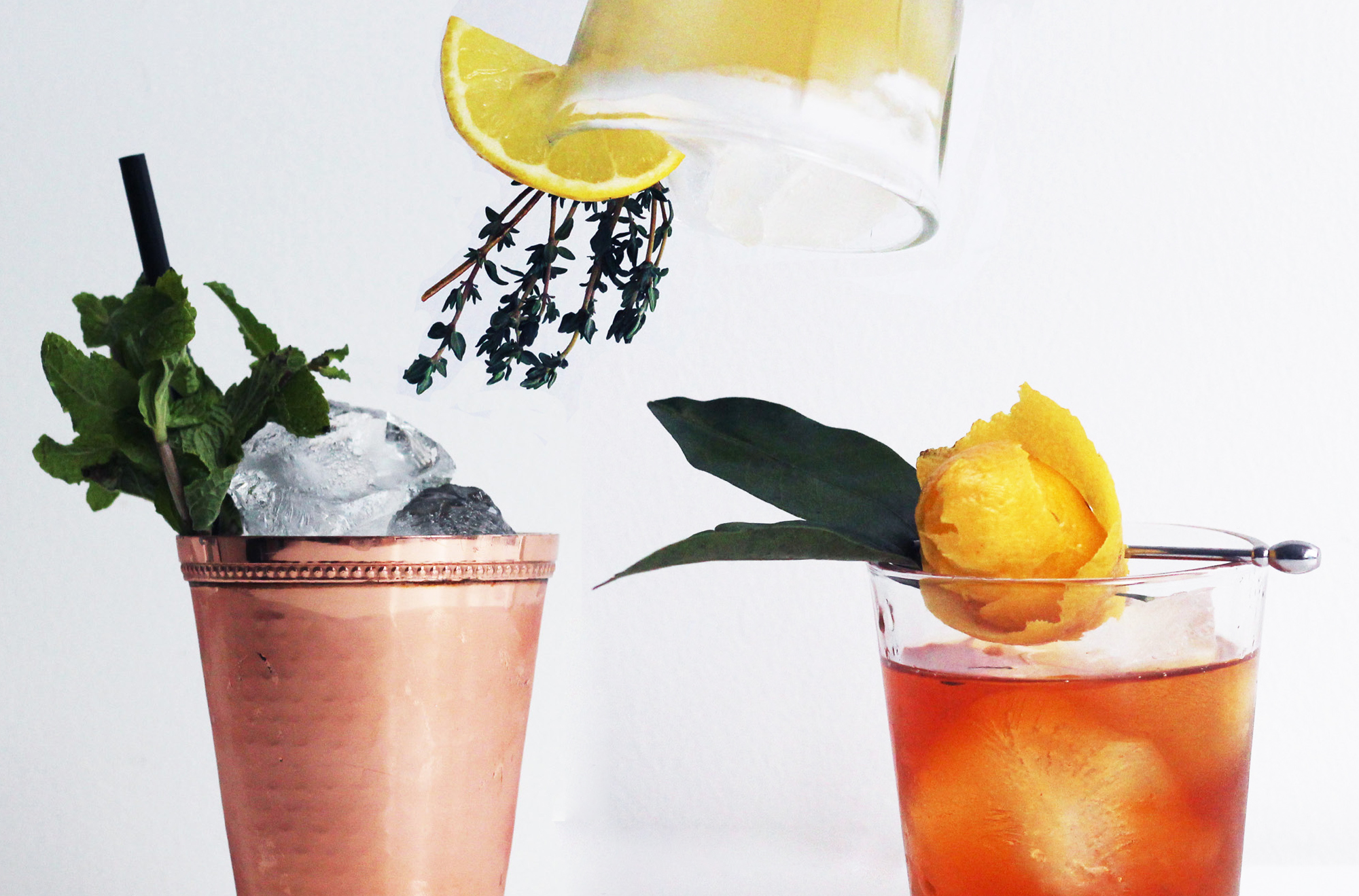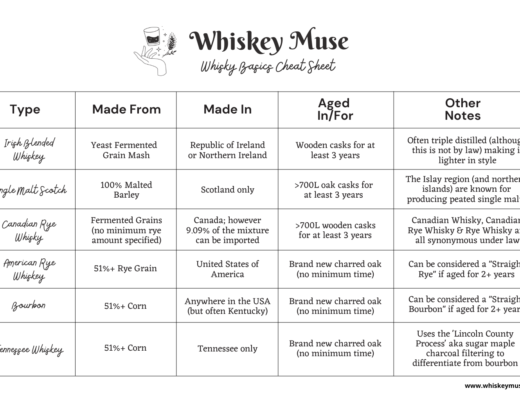When we look at different industries there is a certain jargon or technical language that the inexperienced may find overwhelming.
In cooking, knowing the difference between chopping, mincing, julienning or batonnetting is important for food preparation – but in layman’s terms they’re all ways to cut up ingredients. And in boxing knowing the difference between jabs, crosses, hooks and uppercuts can win a match – but in layman’s terms they’re all types of punches. Or perhaps in wine knowing the difference between a Chablis, White Burgundy, Blanc de Blanc or Côte de Beaune can mean a completely different flavour profile – but in layman’s terms they’re all made from Chardonnay grapes.
Nevertheless, when making cocktails there are a number of common syrups and mixers that are used in recipes and to the inexperienced, they may seem confusing or technical, but upon further inspection one will find that they are often made out of well known household goods. Below are 13 terms for different types of syrups and mixers that may sound fancy schmancy but are actually very approachable:
SUGAR
1. Simple Syrup (Sugar Water)
It’s just that. Simple. Just a combination of equal parts (1:1) white sugar and water. If you’re making it at home, make sure the water is heated to allow the sugar to dissolve into it.
2. Demerara Syrup (Demerara Sugar Water)
[dem-err-air-ah]
Similar to Simple Syrup, this uses equal parts (1:1) demerara sugar and water. What’s demerara you ask? It’s a raw cane sugar that’s minimally refined and has a larger grain to it. Don’t mistake it though for “brown sugar” as they’re not one in the same. Brown sugar is essentially just white sugar that’s been lightly bathed in molasses (in other words it’s super refined). Because demerara sugar has more of a caramel/molasses flavor than that of white sugar, this type of syrup will add additional flavor notes to your cocktail vs. just sweetening it.
SALT + OIL
3. Saline Solution (Salt Water)
[say-lean]
Yes, some cocktails will call for a drop or two of “saline solution” which is essentially just dissolved salt in water. Why you may ask? Well while the science isn’t confirmed, just like adding salt to your meal, salt will enhance a cocktail. According to some bakers, chefs and bartenders, a touch of salt will highlight sweetness, brighten acidity and mute bitterness. But beware, only add a few drops or else the salt will become the main player as opposed to the supporting act in your drink.
4. Oleo Saccharum (Oil + Sugar)
[ol-ee-oh saka-rum]
Oleo, which means oil or fat and saccharum, which means sugar, is quite literally an oily sugar. It became popular in the 19th century as a way to add sweetness, flavor and aromatics to cocktails. Essentially you just need some citrus peels (i.e. lemon, lime, grapefruit, orange etc.) and some sugar. You get the peels, add the sugar, muddle them together and allow some time for the peels to release the oils.
FRUIT + SUGAR
5. Lime Cordial (Lime Sugar Water)
[cor-dee-ull]
While many store-bought lime cordials have additional ingredients added to it, lime cordial is a non-alcoholic syrup (or cordial) that is made from limes, sugar and water. Many recipes call for using the lime juice and the lime rinds in the making of it (the rinds contain delicious essential oils and add some bitterness). Note that the term “cordial” can be used in a variety of ways – in addition to describing this limey sugar water, it can also be a term for sweet liqueurs or a warm/friendly person.
6. Sour Mix (Lemon + Lime Sugar Water)
Similar to lime cordial, sour mix is a blend of equal parts lemon juice, lime juice and sugar water (simple syrup). Beware of store-bought sour mixes (the backbone to happy hour $3 margaritas + whisk(e)y sours) as they are packed with additives and chemicals that help preserve the syrup.
7. Grenadine (Pomegranate Sugar Water)
[gren-a-deen]
You may have thought that grenadine was made from cherries, and yes, some store-bought ones have become that, but the original grenadine was never cloyingly sweet – no, it was a sweet and tart syrup made from pomegranate juice and sugar water. While the ingredients for different recipes may very, grenadine should definitely NOT include high fructose corn syrup.
8. Shrub (Fruit + Vinegar + Sugar)
Also known as a drinking vinegar, shrubs became popular during America’s colonial era back when they were looking for creative ways to preserve fruit in the off-seasons. Let me just say that shrubs are making a come back and provide sweet and sour for cocktails. While any vinegar will do in making a shrub, I would recommend using champagne vinegar, apple cider vinegar, or if you’re feeling particularly adventurous, balsamic vinegar.
SPICE
9. Tincture (Organic Material + Alcohol)
[tink-sure]
Tinctures are liquid extracts that have long been used in medicine as remedies for the ill. However, they have also been found to play a role in adding depth and complexity to cocktails without too much dilution. Tinctures are essentially any organic material (i.e. fruit, vegetable, root, bark, leaf, herb, spice etc.) that is placed in a high-proof neutral alcohol (so usually vodka although there are exceptions). Over time the alcohol extracts the materials’ flavour and helps to preserve it for long term use.
10. Bitters (Bitter Roots + Organic Material + Alcohol)
Bitters are like next level tinctures in that they are liquid extracts of an assortment of fruits, vegetables, roots, bark, herbs, spices etc. The main difference is that these extracts require that there be a bittering agent in them (surprise surprise) that is at a level where the extract is non-potable (read: not drinkable). I mean it can be drinkable in small portions, but not in shot-sized portions. Some of the “bittering agents” that are used to make bitters bitter include dandelion root, gentian root, hops (like in beer), quassia bark, burdock root, chinchona bark and citrus peels. Two of the most popular commercial bitters out there are Angostura and Peychauds.
TIKI
11. Orgeat (Almonds + Sugar Water + Orange Blossom Water)
[ohr-zhat]
If you like marzipan, you’re going to love orgeat. Fun to say and to use in cocktails. You will oftentimes find orgeat in tiki-style cocktails similar to the next two terms. While tiki-culture originated in Polynesia, orgeat has French origins. “Orge” comes from the French word for barley and that’s precisely what it was made from (along with almond) back in the day. Most well known as an ingredient in a Mai Tai, to make your own orgeat you just need to grab some almonds and toast them. Food process them and then cook them with some sugar and water. Let sit for awhile and then add orange blossom water and a touch of vodka (for the sake of preservation), fine strain through a cheese cloth and voila – liquid marzipan.
12. Falernum (Ginger + Lime + Clove + Almond + Sugar Water)
[fah-lehr-num]
There’s debate over when falernum first originated – it was either sometime in the late 1800’s or early 1900’s. Regardless, this ingredient is often used in tiki drinks similar (or sometimes alongside) orgeat. While ginger, lime, clove and almond seem to be the main ingredients, varying recipes will used additional spices. Soak some chopped almonds overnight and add them to a pot of water, spice(s), ginger and sugar. Bring to a boil then reduce and simmer for 15 minutes. Add lime zest and put in sealed jar in fridge over night. Strain ingredients out using a cheese cloth or super fine strainer and enjoy.
13. Curaçao (Orange + Sugar + Alcohol)
[kyoo-ruh-sow]
Named after the island of which it was founded, Curaçao is a style of orange liqueur made from lahara orange peels, sugar and alcohol. This island, which is off the coast of Venezuela but is actually a sovereign state of the Netherlands, was cultivated with Valencia oranges by the Spanish. But because the soil and conditions were not ideal, the oranges became small and bitter over time. However, the peels maintained a sweet, fragrant aromatic and began to be used in flavoring a liqueur and thus curaçao was born. Now I know you’re wondering where the blue colour comes from. Well, there’s two different claims to where blue curaçao came first from Lucas Bols (in the Netherlands) and second from Senior Curacao (located on Curaçao). Neither story has been outright confirmed but regardless, the blue makes for a stand-out drink. Marketing win.
So there you have it. 13 syrups/mixers, what they are and how to make them. I know that was a lot of information to read over so to summarize, feel free to download/save this handy dandy chart below which explains what each term is and how to pronounce it:
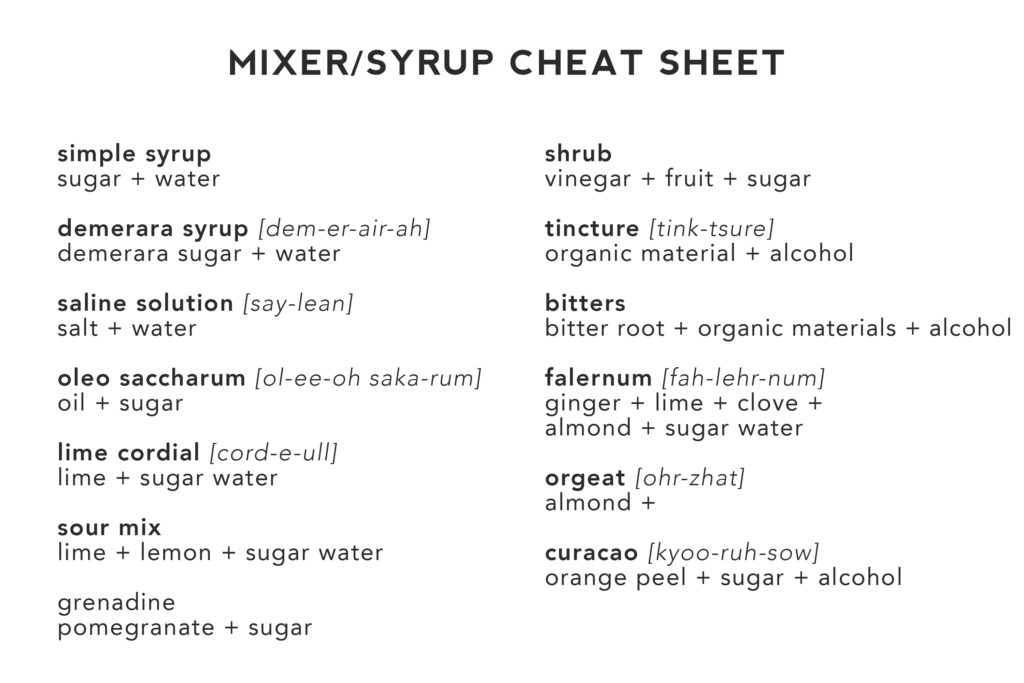
I hope this guide has provided you with some clarity! Let me know if there are any other terms you’re curious about below and stay tuned for another edition like this where we cover bartending materials, spirits, liqueurs and more!

